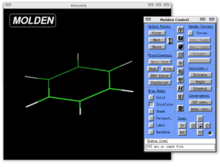Molden
This article has multiple issues. Please help improve it or discuss these issues on the talk page. (Learn how and when to remove these messages)
|
 | |
| Original author(s) | Gijs Schaftenaar |
|---|---|
| Initial release | 10 November 1993[1] |
| Stable release | 6.9
|
| Operating system | Windows OS X Linux[2] |
| License | Proprietary[3] |
| Website | www |
Molden is a general molecular and electronic structure processing program.
Major features
[edit]- Reads output from the ab initio packages GAMESS (US), Gaussian, MOLPRO, PySCF and from semi-empirical packages such as MOPAC, and supports a number of other formats.
- Displays molecular orbitals or electron density as contour plots or 3D grid plots and output to a number of graphical formats.
- Animates reaction paths and molecular vibrations.
- A Z-matrix editor.
Molden program has been tested on different platforms, namely Linux, Windows NT, Windows95, Windows2000, WindowsXP, MacOSX, Silicon Graphics IRIX, Sun SunOS and Solaris.
Ambfor, the main force field module of Molden, is an external program that can be initialized from Molden. Ambfor admits protein force field Amber and GAFF (General Amber Force Field). Use of Ambfor is automatic when a protein is studied with Molden. The GAFF force field is used only small molecules. Both Amber and GAFF are based on atomic charges. The differences are largely in computational cost, with GAFF being very expensive.
Molden can read several file formats with crystal information.
See also
[edit]References
[edit]- ^ "HISTORY". Retrieved 2013-05-02.
- ^ "Currently tested platforms". Retrieved 2013-05-03.
- ^ "CMBI: MOLDEN Copyright". Retrieved 2021-11-27.
Molden: a pre- and post-processing program for molecular and electronic structures.[1]
- ^ MOLDEN Review, Schaftenaar G, Noordik JH. Molden: a pre- and post-processing program for molecular and electronic structures. J Comput Aided Mol Des. 2000 Feb;14(2) 123-134. doi:10.1023/a:1008193805436. PMID 10721501.
